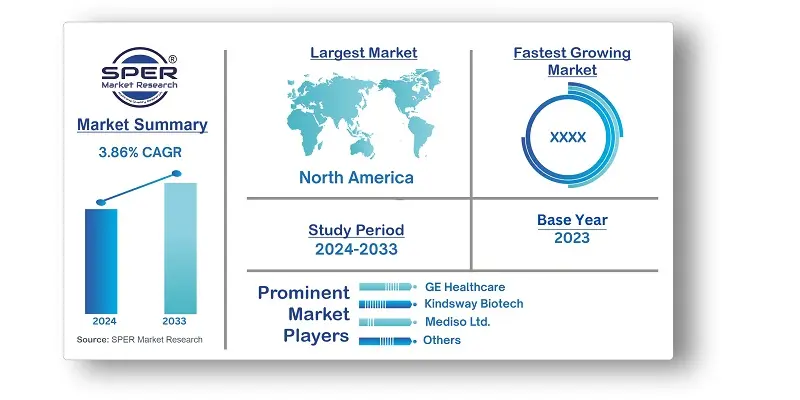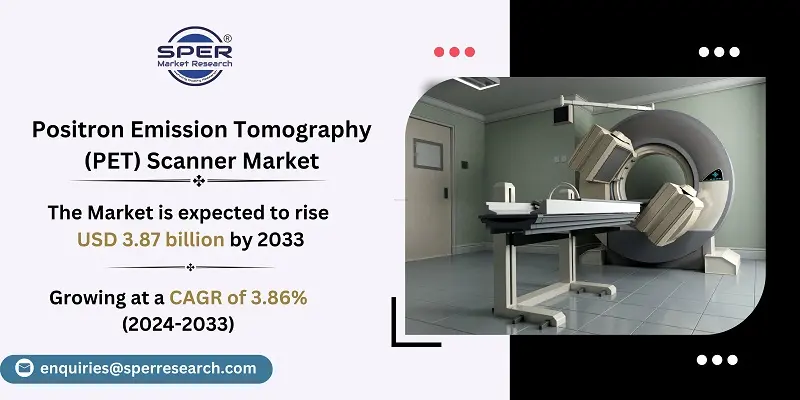
Positron Emission Tomography Scanner Market Trends, Share, Size, Demand and Future Outlook
Positron Emission Tomography (PET) Scanner Market Growth, Size, Trends Analysis- By Modality, By Application, By End User- Regional Outlook, Competitive Strategies and Segment Forecast to 2033
| Published: Nov-2024 | Report ID: MEDE2455 | Pages: 1 - 231 | Formats*: |
| Category : Medical Devices | |||
- In June 2024, enhanced whole-body scanning via magnifying PET (AWSM-PET), a recently introduced technique, demonstrated notable improvements in system sensitivity and picture quality for clinical whole-body PET/CT imaging.
- The groundbreaking Mobile Dedicated Cardiac PET/CT Trailer, which CDL Nuclear Technologies unveiled in April 2024, will revolutionize cardiac treatment by delivering cutting-edge PET/CT imaging services straight to medical facilities on their schedule.


| Report Metric | Details |
| Market size available for years | 2020-2033 |
| Base year considered | 2023 |
| Forecast period | 2024-2033 |
| Segments covered | By Modality, By Application, By End Use |
| Regions covered | North America, Asia-Pacific, Latin America, Middle East & Africa and Europe |
| Companies Covered | Canon Medical Systems, GE Healthcare, Kindsway Biotech, Koninklijke Philips N.V., Mediso Ltd., PerkinElmer, Positron, Shimadzu Corporation, and Siemens Healthineers AG. |
- Hospitals and Healthcare Institutions
- Diagnostic Imaging Centers
- Oncology Clinics
- Neurology Centers
- Research and Academic Institutions
- Pharmaceutical and Biotechnology Companies
- Government Healthcare Agencies
| By Modality Outlook: | |
| By Application: | |
| By End Use: | |
| By Region: |
- Global Positron Emission Tomography (PET) Scanner Market Size (FY’2024-FY’2033)
- Overview of Global Positron Emission Tomography (PET) Scanner Market
- Segmentation of Global Positron Emission Tomography (PET) Scanner Market By Modality (PET-CT, PET-MRI)
- Segmentation of Global Positron Emission Tomography (PET) Scanner Market By Application (Oncology, Cardiology, Neurology)
- Segmentation of Global Positron Emission Tomography (PET) Scanner Market By End User (Hospitals, Diagnostic Imaging Centers, Academic & Research Institutes)
- Statistical Snap of Global Positron Emission Tomography (PET) Scanner Market
- Expansion Analysis of Global Positron Emission Tomography (PET) Scanner Market
- Problems and Obstacles in Global Positron Emission Tomography (PET) Scanner Market
- Competitive Landscape in the Global Positron Emission Tomography (PET) Scanner Market
- Impact of COVID-19 and Demonetization on Global Positron Emission Tomography (PET) Scanner Market
- Details on Current Investment in Global Positron Emission Tomography (PET) Scanner Market
- Competitive Analysis of Global Positron Emission Tomography (PET) Scanner Market
- Prominent Players in the Global Positron Emission Tomography (PET) Scanner Market
- SWOT Analysis of Global Positron Emission Tomography (PET) Scanner Market
- Global Positron Emission Tomography (PET) Scanner Market Future Outlook and Projections (FY’2024-FY’2033)
- Recommendations from Analyst
1.1. Scope of the report1.2. Market segment analysis
2.1. Research data source
2.1.1. Secondary Data2.1.2. Primary Data2.1.3. SPER’s internal database2.1.4. Premium insight from KOL’s
2.2. Market size estimation
2.2.1. Top-down and Bottom-up approach
2.3. Data triangulation
4.1. Driver, Restraint, Opportunity and Challenges analysis
4.1.1. Drivers4.1.2. Restraints4.1.3. Opportunities4.1.4. Challenges
4.2. COVID-19 Impacts of the Global Positron Emission Tomography (PET) Scanner Market.
5.1. SWOT Analysis
5.1.1. Strengths5.1.2. Weaknesses5.1.3. Opportunities5.1.4. Threats
5.2. PESTEL Analysis
5.2.1. Political Landscape5.2.2. Economic Landscape5.2.3. Social Landscape5.2.4. Technological Landscape5.2.5. Environmental Landscape5.2.6. Legal Landscape
5.3. PORTER’s Five Forces
5.3.1. Bargaining power of suppliers5.3.2. Bargaining power of buyers5.3.3. Threat of Substitute5.3.4. Threat of new entrant5.3.5. Competitive rivalry
5.4. Heat Map Analysis
6.1. Global Positron Emission Tomography (PET) Scanner Market Manufacturing Base Distribution, Sales Area, Product Type6.2. Mergers & Acquisitions, Partnerships, Product Launch, and Collaboration in Global Positron Emission Tomography (PET) Scanner Market
7.1. Global Positron Emission Tomography (PET) Scanner Market Size, Share and Forecast, By Modality Outlook, 2020-20267.2. Global Positron Emission Tomography (PET) Scanner Market Size, Share and Forecast, By Modality Outlook, 2027-20337.3. PET-CT7.4. PET-MRI
8.1. Global Positron Emission Tomography (PET) Scanner Market Size, Share and Forecast, By Therapeutic Areas, 2020-20268.2. Global Positron Emission Tomography (PET) Scanner Market Size, Share and Forecast, By Therapeutic Areas, 2027-20338.3. Oncology8.4. Cardiology8.5. Neurology
9.1. Global Positron Emission Tomography (PET) Scanner Market Size, Share and Forecast, By End User, 2020-20269.2. Global Positron Emission Tomography (PET) Scanner Market Size, Share and Forecast, By End User, 2027-20339.3. Hospitals9.4. Diagnostic Imaging Centers9.5. Academic & Research Institutes
10.1. Global Positron Emission Tomography (PET) Scanner Market Size and Market Share
11.1. Global Positron Emission Tomography (PET) Scanner Market Size and Market Share By Region (2020-2026)11.2. Global Positron Emission Tomography (PET) Scanner Market Size and Market Share By Region (2027-2033)11.3. Asia-Pacific
11.3.1. Australia11.3.2. China11.3.3. India11.3.4. Japan11.3.5. South Korea11.3.6. Rest of Asia-Pacific
11.4. Europe
11.4.1. France11.4.2. Germany11.4.3. Italy11.4.4. Spain11.4.5. United Kingdom11.4.6. Rest of Europe
11.5. Middle East and Africa
11.5.1. Kingdom of Saudi Arabia11.5.2. United Arab Emirates11.5.3. Qatar11.5.4. South Africa11.5.5. Egypt11.5.6. Morocco11.5.7. Nigeria11.5.8. Rest of Middle-East and Africa
11.6. North America
11.6.1. Canada11.6.2. Mexico11.6.3. United States
11.7. Latin America
11.7.1. Argentina11.7.2. Brazil11.7.3. Rest of Latin America
12.1. Canon Medical Systems
12.1.1. Company details12.1.2. Financial outlook12.1.3. Product summary12.1.4. Recent developments
12.2. GE Healthcare
12.2.1. Company details12.2.2. Financial outlook12.2.3. Product summary12.2.4. Recent developments
12.3. Kindsway Biotech
12.3.1. Company details12.3.2. Financial outlook12.3.3. Product summary12.3.4. Recent developments
12.4. Koninklijke Phillips N.V.
12.4.1. Company details12.4.2. Financial outlook12.4.3. Product summary12.4.4. Recent developments
12.5. Mediso Ltd.
12.5.1. Company details12.5.2. Financial outlook12.5.3. Product summary12.5.4. Recent developments
12.6. PerkinElmer
12.6.1. Company details12.6.2. Financial outlook12.6.3. Product summary12.6.4. Recent developments
12.7. Positron
12.7.1. Company details12.7.2. Financial outlook12.7.3. Product summary12.7.4. Recent developments
12.8. Shimadzu Corporation
12.8.1. Company details12.8.2. Financial outlook12.8.3. Product summary12.8.4. Recent developments
12.9. Siemens Healthineers AG
12.9.1. Company details12.9.2. Financial outlook12.9.3. Product summary12.9.4. Recent developments
12.10. Others
SPER Market Research’s methodology uses great emphasis on primary research to ensure that the market intelligence insights are up to date, reliable and accurate. Primary interviews are done with players involved in each phase of a supply chain to analyze the market forecasting. The secondary research method is used to help you fully understand how the future markets and the spending patterns look likes.
The report is based on in-depth qualitative and quantitative analysis of the Product Market. The quantitative analysis involves the application of various projection and sampling techniques. The qualitative analysis involves primary interviews, surveys, and vendor briefings. The data gathered as a result of these processes are validated through experts opinion. Our research methodology entails an ideal mixture of primary and secondary initiatives.



Frequently Asked Questions About This Report
PLACE AN ORDER
Year End Discount
Sample Report
Pre-Purchase Inquiry
NEED CUSTOMIZATION?
Request CustomizationCALL OR EMAIL US
100% Secure Payment






Related Reports
Our Global Clients
Our data-driven insights have influenced the strategy of 200+ reputed companies across the globe.






















